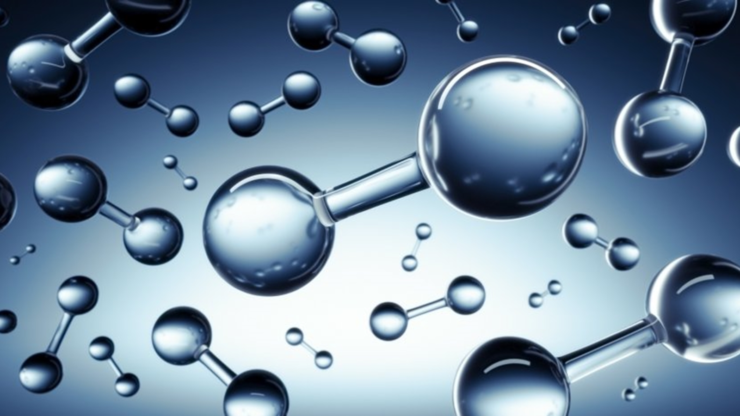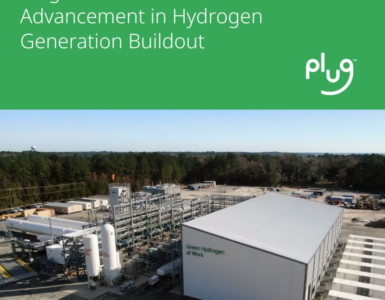New tech breakthrough makes $2.5 trillion hydrogen boom possible.
The U.S. government has announced a proposed $7 billion (for starters) on desperately needed breakthroughs in clean hydrogen production. The Department of Energy’s (DoE) biggest bet is on nuclear power plants, which they are hoping to convert into North America’s premier clean hydrogen producers.
Companies mentioned in this release include: Ballard Power Systems Inc. (NASDAQ: BLDP), Plug Power Inc. (NASDAQ: PLUG), Linde plc (NYSE: LIN), Shell (NYSE: SHEL), BP (NYSE: BP).
Those billions of dollars are being poured into technological innovation, lowering costs and scaling up the production of clean hydrogen, including through the use of nuclear power plants in New York, Ohio, Minnesota and Arizona.
For now, the majority of hydrogen in the United States is produced by natural gas reforming in large central plants—an important step in the energy transition. The end goal, however, is to produce hydrogen without creating carbon emissions, and that’s what the federal government’s $7billion spend is all about.
At four nuclear plants across the country, scientists are trying to perfect a process called ‘electrolysis’ to create pure, clean hydrogen. The process involves splitting water into pure hydrogen and oxygen using high temperature electrolyzers. For now, however, the process is prohibitively expensive and energy intensive.
That could make this recent breakthrough all the more significant …
GH Power has developed a unique renewable energy technology that uses exothermic reactions to create three highly sought-after green outputs: hydrogen, alumina (aluminum oxide) and exothermic heat, killing three birds with one high-tech stone.
🔥 What about we co-host a webinar? Let's educate, captivate, and convert the hydrogen economy!
Hydrogen Central is the global go-to online magazine for the hydrogen economy, we can help you host impactful webinars that become a global reference on your topic and are an evergreen source of leads. Click here to request more details
The hydrogen produced by the modular version of GH Power’s 2MW reactor is pure and clean, with zero emissions, zero carbon and zero waste, using only 2 inputs (recycled aluminum and water).
GH Power has been developing the new type of reaction for hydrogen production over the past 7 years, and now it’s gearing up to flip the switch on the first commercial reactor of its kind in Hamilton Ontario, Canada.
Flipping the switch on this new reactor comes at a critical juncture in the global energy transition. The Hydrogen Council estimates that hydrogen will represent 18% of all energy delivered to end users by 2050, avoiding 6 gigatonnes of carbon emissions annually and turning around an approximated $2.5 trillion in annual sales (not to mention creating 30 million jobs globally).
VISUALIZING A FUTURE POWERED BY CLEAN HYDROGEN
GH Power’s reactor is self-sustaining, zero emission and is a net producer of energy for consumption. It’s 100% clean and modular, which means it can be assembled on site to power North America’s industries for the first time with clean energy and cost competitive with conventional fossil fuels.
It also produces green hydrogen, exothermic heat, as well as highly valuable green alumina, which has numerous commercial applications used for everything from lithium-ion batteries and LED lighting to semiconductor production.
The GH Power process is proprietary and breakthrough:
GH Power is planning to develop a plant which produces 11,700 Tonnes of green hydrogen per year to fuel 30 MW combined cycle plant with a net output of 27 MW.
For now, the DoE puts the cost of producing hydrogen from renewable energy at about $5 per kilogram, which is about 3X higher than the price of producing hydrogen from natural gas. The DoE’s goal is to see clean hydrogen production costs decline by 80% to $1 per kilogram in a decade.
By the company’s estimates, GH Power’s reactor is already 60% cheaper than producing hydrogen by electrolysis, and it is a net producer of electricity to the grid. Its green alumina co-product production costs are also over 85% cheaper than the most commonly used processes currently used for alumina production that rely on hydrochloric acid leaching and hydrolysis for alumina production. This could be a game changer in the decarbonization of the critical sector.
Finally, GH Power’s base 27MW net output plant design is forecast to produce a carbon offset of 1.2 million tonnes annually (based on displacing a coal fired plant the same size)
The company has also had successful tests using scrap steel (iron) as another metal fuel for hydrogen generation. The use of recycled metals provides a scalable solution with a much lower costs basis at under a $1/kg hydrogen. Scrap iron is the most widely available metal fuel in most markets. Not only is this a cost breakthrough, but it is a proprietary technology that embraces the idea of a circular economy with zero emissions.
The process uses recycled scrap aluminum as the key input. That aluminum is then mixed with water through a proprietary reactor designed to continuously operate to produce hydrogen, alumina and exothermic heat (power) with zero emissions. Scrap or recycled aluminum is widely available in almost every market, and can be found for as little as $1.50/kg.
It’s a new technology that can run full circle from using recyclable materials to help other companies, organizations, and industries to meet their own net-zero commitments. And it’s all modular and brings the energy to within the last mile of the energy user. For hydrogen, it could be a huge competitive advantage to be able to build a plant right where it’s needed, without massive hydrogen storage facilities and without transportation needs.
FLIPPING THE SWITCH ON THE FIRST REACTOR
GH Power and its team of engineers have already completed Phase 1 testing of their 2MW reactor in Hamilton, Ontario, and Phase 2 testing began on June 30th. Next step is to move into commercial operations and 24-hour continuous operations.
Revenue generation is forecast to begin in the fourth quarter, and then the future is all about scaling up from 2MW reactors to a 27MW Net Output power solution.
The scaled-up 27 Net Output MW version of this reactor, planned for the near future, will produce the same three green outputs which can be blended with natural gas in a turbine. This could allow GH Power’s solution to integrate with existing natural gas power plants and allow companies to utilize existing assets while making a serious reduction in CO2 emissions.
The world needs 520 million tonnes of hydrogen to achieve net-zero targets by 2050, according to the International Energy Agency (IEA). Given the current state of advancement with electrolysis for producing hydrogen and the associated costs, we won’t make that goal without alternative breakthroughs such as GH Power’s.
This award-winning technology is the result of seven years of painstaking research by world-class scientists and engineers, led by GH Power CEO Dave White, a veteran engineer in the power generation space. Combined, the GH Power team has, has well over a century of power generation experience in the design, build and operation of power plants, refineries, and other energy infrastructure.
Chief Engineer Ken Stewart has been designing and managing thermal power plant and petrochemical processes for over four decades and across eight different power plants in North Americ, while COO Gary Grahn brings to the table 25 years of international energy experience, including in oil, gas, minerals, metals and utilities.
GH Power has been working closely with Carleton University and is the recipient of a $2.2-million grant from a joint German-Canadian government program as part of Canada’s alliance with Germany to bolster its hydrogen strategy. It’s a feather in Canada’s cap as the country seeks to become a top global supplier of clean hydrogen with a transatlantic supply chain.
The idea itself is in line with what world-renowned physicist Neil de Grasse Tyson calls the ‘cosmic perspective.’ Large-scale green hydrogen projects in existence today are only as clean as the energy required to produce them and only as plausible as the cost required to get to the end game.
Dave White, GH Power CEO said:
The only practical solution for society to reduce carbon emissions is to transition from 100% fossil fuels to cleaner tech, and one of the steps in tackling this is to blend cost competitive green hydrogen with fossil fuels and ramp up the hydrogen content whenever possible.
Hydrogen Is Everywhere
Ballard Power Systems Inc. (NASDAQ:BLDP) has firmly established its presence in the vanguard of the fuel cell revolution. Their pioneering proton exchange membrane (PEM) technology is powering various transportation sectors, ranging from buses to trains. This makes Ballard not just a producer, but an influencer, guiding the green transit narrative globally.
The broader vision of Ballard is shaping the industry’s future trajectory. Investors looking to align with a forward-looking company would find Ballard’s approach and ethos resonating with global sustainability goals.
Plug Power Inc. (NASDAQ:PLUG) innovative hydrogen fuel cell systems are carving a new path in the green energy sector. Their solutions, aimed at replacing conventional batteries, mark a transformative shift in energy storage and application.
The commitment Plug Power demonstrates toward a sustainable energy future makes it a critical player in the hydrogen space. As industries transition, investors can anticipate a rising demand for Plug Power’s trailblazing solutions.
Linde plc (NYSE:LIN), with its extensive history in the industrial gas domain, is making commendable strides in the hydrogen space. Their approach is holistic, focusing on every aspect from production to infrastructure, underscoring a commitment that feels both deep and genuine.
Linde offers stability and innovation in equal measure for investors. Their vast experience combined with a proactive approach to the hydrogen revolution paints a picture of steady growth and visionary leadership.
Shell’s (NYSE:SHEL) transition narrative is both fascinating and instructive. Moving from a traditional oil major to a diversified energy company, their hydrogen initiatives reflect a broader shift towards sustainability and innovation.
Their projects in the hydrogen domain, from refueling stations to research collaborations, indicate a comprehensive and future-ready strategy. Shell’s pivot towards hydrogen is not an afterthought; it’s an integral part of their future roadmap.
BP’s (NYSE:BP) rebranding from ‘British Petroleum’ to ‘Beyond Petroleum’ is symbolic of its evolution. Once a stalwart of the traditional energy sector, it’s now championing the green energy revolution, with hydrogen being a key focus.
Their endeavors in hydrogen, be it through investments or partnerships, showcase a progressive mindset. By positioning hydrogen as a cornerstone of their future growth strategy, they’re aligning with global sustainability goals.
READ the latest news shaping the hydrogen market at Hydrogen Central
New Tech Breakthrough Makes $2.5 Trillion Hydrogen Boom Possible, LONDON, August 25, 2023








